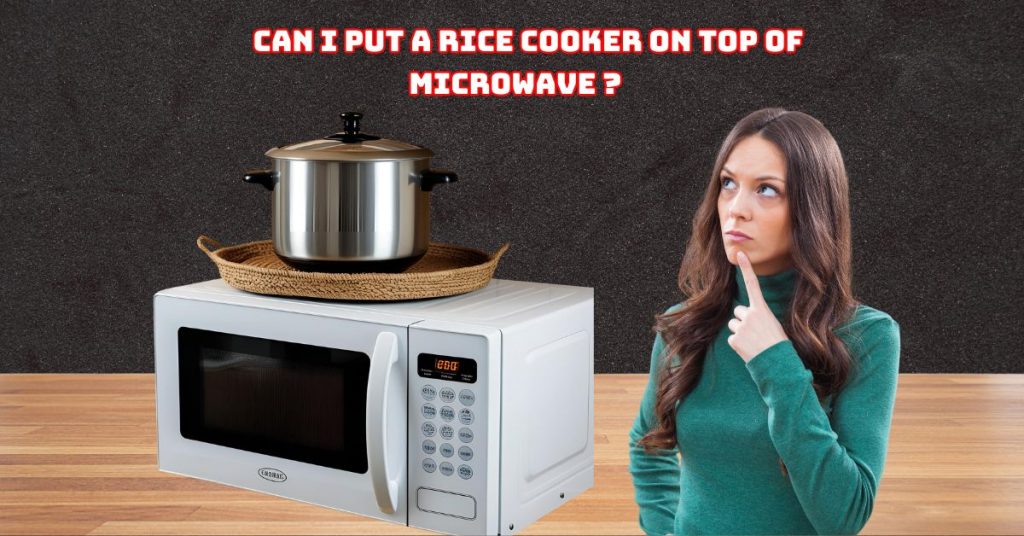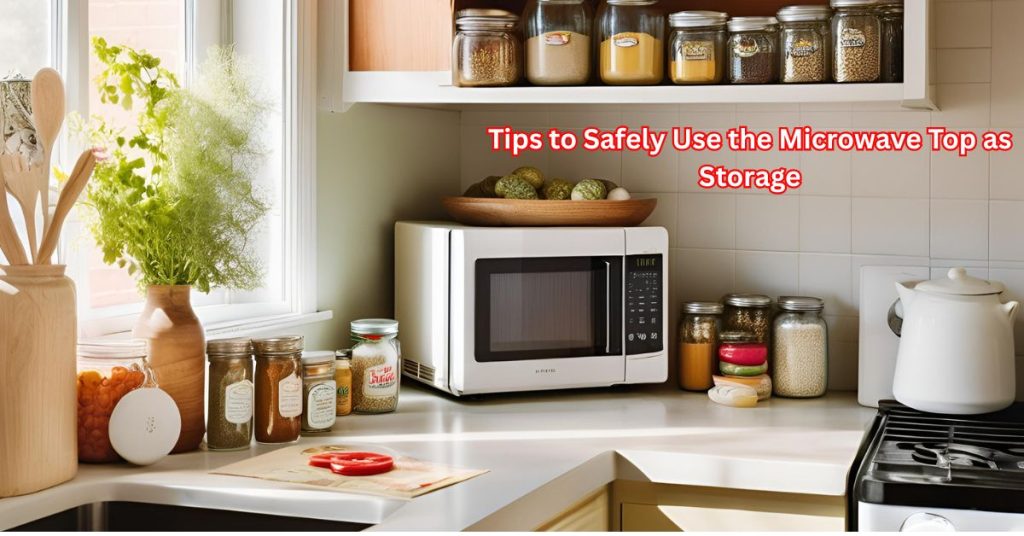Table of Contents
I once stacked a rice cooker on top of my microwave to save space—big mistake. The heat built up, things slid off, and I ended up cleaning sauce off the wall. It made me stop and wonder: can you put anything on top of a microwave, really? Over time, I’ve learned what’s safe, what’s not, and how much weight a microwave can actually hold. In this guide, I’ll share everything I’ve figured out so you don’t make the same messy mistake.
Is It Safe to Put Anything on Top of a Microwave?
It might look like the perfect storage spot, but stacking things on top of a microwave isn’t always safe. Microwaves give off heat while running, and many have vents on the top or sides to release that heat. Block those vents, and you’re asking for trouble—overheating, poor performance, or even permanent damage. There’s also a bit of concern about electromagnetic fields (EMFs), though for most modern models, that’s well-contained. Still, anything too close to the vents or the surface can affect how well the appliance works—or worse, become a fire risk.
Most manufacturers play it safe and recommend keeping the top of the microwave clear, or only placing lightweight, heat-resistant items. If your manual mentions a weight limit or clearance space, follow it. Brands like Panasonic and Samsung often state that vents should be free from obstruction by at least 2–3 inches. That’s not just a suggestion—it’s there to protect both the machine and your kitchen.
Now, I’ll be honest—I’ve tested the limits. I once kept my tea set and a mini spice rack on top of mine. At first, it seemed fine… until the microwave started making weird noises, and the bottom of one of my spice jars melted slightly. That’s when I realised I was pushing it. Ever since, I’ve been a bit more cautious. Trust me—learning from a melted spice jar is not the most elegant way to figure it out!
How Much Weight Can I Put on Top of a Microwave?
**Most microwaves can safely hold between 5 to 15 kilograms on top—**but that doesn’t mean you should push it to the max. The exact limit depends on the model, its size, and how it’s built. For example, my old budget microwave groaned under anything over 7kg, while my newer Panasonic one feels sturdier—but even then, I never go over 10kg just to be safe.
So, how much weight can you put on top of a microwave? Check your user manual first. Most brands include a recommended limit, and many stress that the vents need 2–3 inches of breathing space. If you block the vents—even with something light—you risk overheating or damaging the unit’s internal parts. Think of it like wearing a thick jumper in summer. You’ll feel the heat, and so will your microwave.
When I tested mine, I placed a few cookbooks, a basket, and a digital scale to get the total weight right. I kept it under 8kg and monitored it for noise or wobbling. It stayed stable and didn’t heat up on top—so I considered that a win. But I’ve also tried stacking more once (silly me), and the microwave started vibrating like it was about to lift off.
Warning signs that you’ve gone too far:
- Vibrating or louder humming
- Warm or hot top surface
- Shifting items during operation
- Unusual smells or sounds
One time, I ignored a buzzing sound—and my glass jar cracked from the heat. Don’t let curiosity cost you a kitchen tool (or worse, the microwave).
Can I Put a Rice Cooker on Top of Microwave?

Not a good idea. A rice cooker and a microwave both generate heat. Stacking one hot appliance on top of another is like wearing a winter coat to the beach—unnecessary, uncomfortable, and asking for trouble. When both are running, heat builds up fast, and that’s a risk to both machines and your kitchen safety.
Can I put a rice cooker on top of a microwave? Technically, yes—but it’s not safe or recommended. Most microwaves have vents on the top or sides, and placing a rice cooker there can block airflow. That trapped heat has nowhere to go, and over time, it can damage internal parts, affect performance, or even lead to electrical faults. Trust me, it’s just not worth the risk.
I actually tried it once—just once. I thought I’d be clever and save space during a dinner rush. But halfway through, the microwave’s exterior felt way too warm, and the rice cooker was wobbling every time the microwave turned on. It scared me enough to never try that setup again. Stacking heat on heat is a no-go, especially in a small kitchen where airflow already struggles.
So what’s the better option? I now keep my rice cooker on a rolling shelf next to the microwave. That way, I can pull it out when I need it and keep the microwave top free. If you’re short on counter space, think vertically—but safely. A mounted shelf or a microwave rack with an open top is a smarter, safer choice.
In short, if it heats up, it stays off the microwave. That’s my golden rule. And once you see how much smoother things run without the balancing act, you’ll thank yourself too.
What Items Are Safe to Stack on a Microwave?
Here’s the good news: Yes, you can put some things on top of a microwave—just be smart about it. After years of experimenting, I’ve figured out a safe list:
✅ Safe to Stack
- Lightweight baskets or trays: Great for storing tea bags, snacks, or napkins. Just make sure they don’t trap heat or block vents.
- Cookbooks (a few): One or two is fine, but skip the whole library.
- Plastic containers (empty or dry goods): Use heat-resistant plastic and keep them light.
- Bread bins or cool toaster ovens: If they’re not in use and the bottom stays cool, it’s usually okay.
Snippet-ready: Cookbooks, plastic containers, and lightweight baskets are safe on top of a microwave if they’re heat-resistant and don’t block airflow.
❌ Not Safe to Stack
- Metal containers or utensils: These can heat up fast and cause burns—or even short circuits.
- Electronics (blenders, kitchen timers, etc.): Sensitive to heat and vibrations. Not worth the risk.
- Heavy appliances: They can shift, vibrate, or even dent the microwave.
- Liquids: Spills + electronics = disaster.
Snippet-ready: Avoid storing heavy appliances, electronics, metal, or liquids on top of your microwave.ave.
Tips to Safely Use the Microwave Top as Storage

If you must use the space, here are a few tricks I swear by:
- Use a heat-resistant mat or silicone tray.
I use a cork mat to add grip and insulate any stored items from residual heat. Snippet-ready: A heat-resistant mat on top of your microwave adds safety and prevents sliding. - Leave 2–3 inches for ventilation.
Even a little airflow makes a big difference. Shift things back or up if needed. - Never stack electronics.
I learned this when my kitchen timer malfunctioned from heat exposure. Keep it away. - Try a spice tray with rubber feet.
My go-to setup—light, non-slip, and handy while cooking.
Final tip: Treat your microwave like a fragile shelf—it can store a little, but not everything.
What the Experts Say
Still unsure whether you can put anything on top of a microwave? Let’s hear it from the pros. While I’ve learned a lot through hands-on trial and error, I always like to cross-check with trusted sources—and what they say really backs up the caution.
According to Electrical Safety First, one of the UK’s leading authorities on home appliance safety, microwaves should always have proper ventilation around them—especially at the top. Blocking vents with heavy items or heat-sensitive materials can lead to overheating, reduced performance, or worse, fire risks. Snippet-ready: UK safety experts warn that blocking microwave vents can cause overheating and serious hazards.
Brands like Samsung and Panasonic echo the same advice in their manuals. I checked mine (yes, I keep the little booklets!), and both clearly state not to store heavy or heat-sensitive items on top. They also advise keeping the top clear if the vents are located there, and to allow at least 2 to 3 inches of space for airflow.
So why does it matter? Well, microwaves aren’t just flat boxes—they’re machines that need to breathe. Trapping heat inside can shorten the appliance’s lifespan, warp internal parts, or even crack the outer casing over time. One Samsung manual even mentioned that items like foil, liquids, or electronics should never be placed on top due to electromagnetic interference and heat risk.
I know it sounds a bit dramatic—but when you see this advice repeated across brands and safety boards, you realise it’s not just overcautious. It’s based on real incidents and long-term product testing.
Snippet-ready: Microwave manufacturers like Panasonic and Samsung recommend keeping the top clear or using only light, heat-resistant items.
And here’s where experience meets expertise: what I’ve learned through trial, the experts have backed with science. It’s not about being overly cautious—it’s about treating your microwave with the respect it deserves, so it keeps serving you safely for years.
Final Thoughts
So, can you put anything on top of a microwave? The short answer is: not quite. While some light, heat-resistant items are totally fine, others—especially heavy or heat-generating ones—can cause more harm than good. Trust me, I’ve learned that the hard way.
From personal slip-ups to expert-backed advice, one thing’s clear: your microwave needs space to breathe. Keep the vents clear, stick to light storage, and always double-check your manual before using the top as a shelf.
My final tip? When in doubt, keep it light—or keep it off. That simple rule has saved me a few headaches (and a few ruined spice jars). If you’re ever unsure, your manufacturer’s manual is the best place to start. It knows your microwave better than anyone else.
Also Read…How to Take Care of Microwave Oven Easily
FAQs
Is it safe to stack things on a microwave?
Yes, but only lightweight, heat-resistant items—and never anything that blocks the vents. Avoid electronics, heavy appliances, or anything that could melt or tip over.
Snippet-ready: You can stack things on a microwave if they’re light, heat-safe, and don’t block airflow.
How much weight can you put on top of a microwave?
Most microwaves can handle between 5 and 15 kilograms, depending on the brand and model. Always check your user manual for specific limits.
Snippet-ready: You can usually put 5–15kg on a microwave, but always check the manufacturer’s guide.
Can I put kitchen appliances on top of a microwave?
It’s not recommended, especially for heat-generating appliances like rice cookers or kettles. They block airflow and may overheat or damage the microwave.
Snippet-ready: Don’t place other kitchen appliances on your microwave—especially if they generate heat.
What happens if you block microwave vents?
Blocked vents can lead to overheating, reduced cooking performance, or even permanent damage to the appliance. In extreme cases, it may become a fire risk.
Snippet-ready: Blocking microwave vents can cause overheating, poor performance, or damage.

